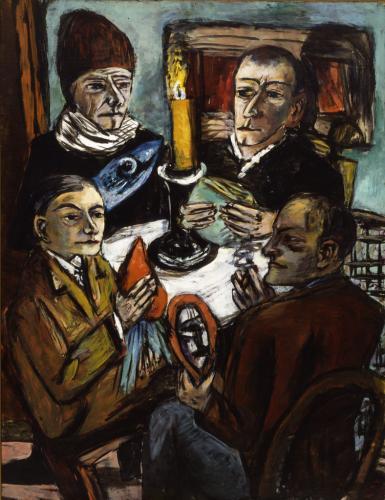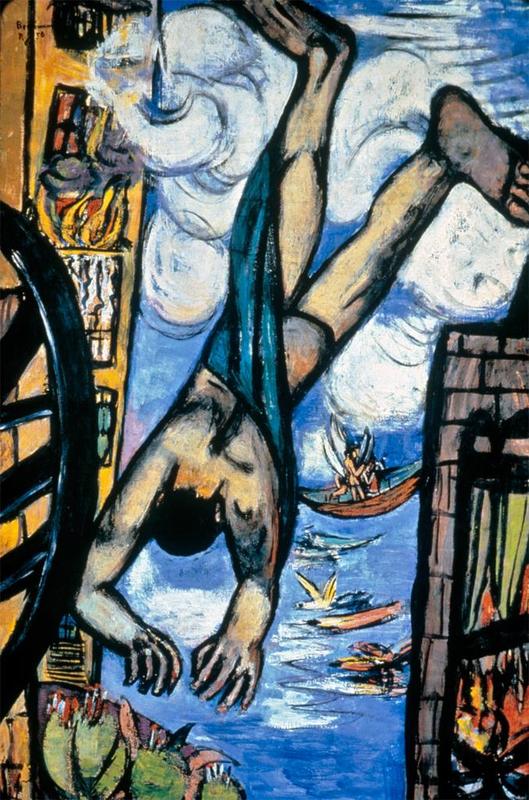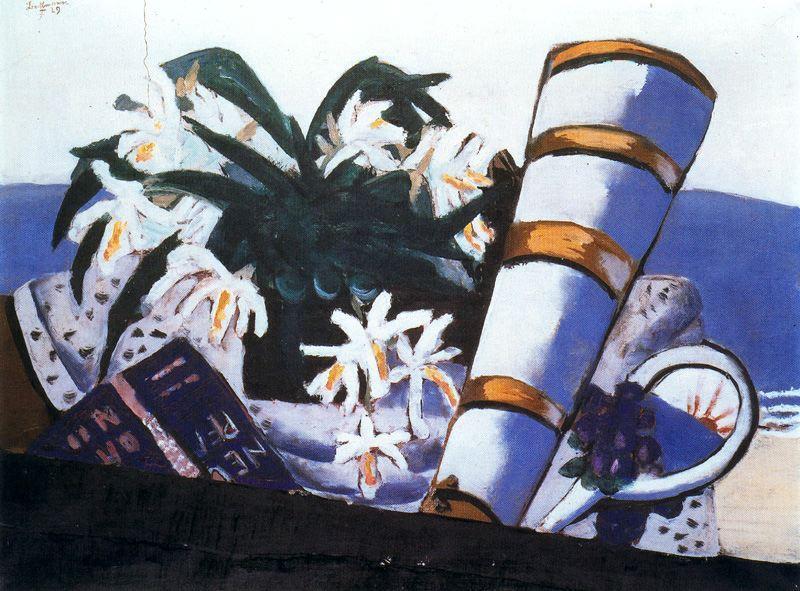Artists With Vegetables: Conflating Utopia and Dystopia

(Cat. 3) Max Beckmann, Artists with Vegetable, 1943, oil on canvas, 58 5/16 x 45 3/16, Kemper Art Museum.
Beckmann’s “real world of objects and events, of pleasure and suffering is a union of heaven and hell.”[i] Within their respective texts Charles W. Haxthausen and Carla Schulz-Hoffman follow the framework outlined by Charles S. Kessler in this quote and chronicle the destabilizing role the mingling of these two subjects plays in Beckmann’s works Falling Man (Figure 1) and Sunrise (Figure 2).[ii] Similarly, Beckmann’s 1937 work, Artists with Vegetables (Cat. 3) exists as an awkward mixture of the two poles that define the boundaries of his “dualistic universe.”[iii] Painted in Holland, during the growing threat of Nazi expansion his work strives toward similar goals as the first generation of Expressionists, but looks much more skeptically at the possibility of the establishment of a pre-modern Arcadian utopia in the presence of a larger modern dystopia.[iv]
Haxthausen’s essay “A Poetics of Space” thoroughly examines the ambiguous conflation of utopia and dystopia in Beckmann’s Falling Man (Figure 1). In particular, Haxthausen examines how the scene oscillates between existing as a portrayal of a man falling to his death or a depiction of this same figure ascending into the sky among angels.[v] He then links this image to Beckmann’s interest in the interconnected and relative relationship of seemingly opposite subjects, citing a Goethe quote Beckmann had chosen to illustrate with a figure strikingly similar to the one included within falling man.
“Descend then! I might also tell you: Soar! / It’s all the same.”[vi]
Carla Schulz-Hoffman also explores the tenuous and unstable boundary between utopia and dystopia in Beckmann’s work in her essay, “Beckmann Matisse and Leger.” Schulz Hoffman argues that in Sunrise (Figure 2) Beckmann looks critically at the notion of an Arcadian utopia. Unlike Matisse, he highlights the possibility that it may be nothing more than an illusion. Schulz-Hoffman states that Beckmann’s depiction of the paradise seen within a mirror operates only as an image of a “distant” promise of utopia, rather than evidence of a truly attainable “reality.” In addition, she notes that in contrast to Matisse who “creates self contained [arcadias] that demand no response,” Beckmann “calls everything into question” in Sunrise.[vii]
Though Schulz-Hoffmann comments on the skeptical and pessimistic attitudes Beckmann’s work, she also highlights a quote within another section of her text that belies Beckmann’s optimistic desire to pursue a path toward arcadia despite its implausibility. In his Creative Credo, Beckmann wrote, “I hope we will achieve a transcendental objectivity out of a deep love for nature and mankind.”[i]

(Figure 1) Max Beckmann. Falling Man, 1950, oil on canvas, 51 ½ x 35 in., Exhibited at Feigen Contemporary, 2002.
In 1937, as the world seemed to crumble under the might of the Nazi Empire, the necessity for the establishment of some form of Arcadia as an escape from their totalitarian forces was growing increasingly apparent. Looking not only to Matisse but to a larger Expressionist tradition, Beckmann picks up on notion promoted by both parties: the reinstatement of a lost harmony between man and nature as a means of achieving utopia and combatting the oppressive forces of the modern world.[i] With Beckmann’s engagement with this tradition in mind, his mysteriously ersatz Artists with Vegetables (Cat. 3), becomes simultaneously a skeptical embodiment of this notion as a path to utopia and an optimistic document of a heroic “against all odds” gesture.
As noted on the website of the Mildred Lane Kemper Museum, this work depicts the “turmoil” of Nazi Europe within the “blazing inferno in the…window behind the artists.” However, “despite the[se] hostilities” the characters act as “shaman-like figures…engag[ing]…in a spiritual, ritualistic ceremony” in an effort to “transcend the desolation of the modern condition.”[ii] Huddled around a candlelit table Beckmann portrays four figures clutching objects he deems “vegetables.” These essential props to be used within this ritual by the artists to somehow to battle the forces of the modern dystopia looming outside are a fish, a carrot, a head of lettuce and a hand mirror. While the first three act as “vegetables” in that they symbolize the natural world, the mirror itself seems to be a reference to the arts and the image making capacity it contains. By means of this decision, Beckmann’s ritual becomes not only a metaphor for an arcadian closeness with nature but art making as well, positing them both as paths to utopia. In a manner similar to Die Brücke’s retreats to Mortizburg, the artists plan to capitalize on the reinstatement of these natural elements and art itself as a defensive mechanism against totalitarian oppression and an offensive force toward arcadia.[iii]
Where Beckmann begins to differ from his predecessors can be seen in the execution of this work. In contrast to the joyfulness and serenity seen in the actualized utopias of artists from which Beckmann appropriates this trope, as in the art of Ernst Ludwig Kirchner, Matisse and Hans Von Marèes, Beckmann’s characteristic solemnness suggests the ritual has left the world unchanged.[i] In line with Kessler’s description of Beckmann’s typical characters, the artists still stare blankly in opposite directions looking dislocated and alienated from their peers.[ii] It seems the ritual has not worked. Furthermore Beckmann portrays the scene not isolated from the rest of the world like the arcadian scenes of Kirchner, Marèes, and Matisse but lodged directly within it. This inclusion keeps the viewer and Beckmann himself from seeing even a successful establishment of microcosmic utopia at the hands of a group of artists as a significant milestone by juxtaposing it with the vast horrors of modernity. In some ways this gesture allows the viewer to see this type of ritualistic retreat as naively optimistic, and selfishly isolationist fueled by a futile and possibly completely fictitious belief in the power of the natural world. Regardless of the moral judgment cast upon them for trying, Beckmann depicts his artist’s as unsuccessful in helping the world actualize utopia so far.
However, in his signature fashion, Beckmann complicates this pessimistic read with the inclusion of strains of optimism and hope. Though the piece acknowledges the existence of the arcadian tradition and asserts that so far it hasn’t managed to work, it also longingly asks, “can we do it?” This tone of hope is echoed by the romance of the candlelight and fits Beckmann’s deeply philosophic ambivalence, described by Kessler as a balance between “metaphysical optimism…and worldly pessimism.”[vi] The ambivalence of this image is heightened by the fact that the frame previously read as a window can also be seen as a painting, speaking this time to dystopia as an illusion. The scene contained within the image and its reality plays an important role in contextualizing the actions of the artists. The merit of their ritual depends first on what appears to exist outside, and secondly on whether or not this scene is a true depiction of the world or simply an illusion.
Through the ambiguity of this device Beckmann allows a viewer living in a time of peace to read this exterior image as a window not looking onto the whole of Nazi destruction but rather simply a fire of even just a painting of fire. In doing so the artist stresses the relativity of perception and judgment and extends this relativity to the assessment of the value of these artist’s ritual. Beckmann asks: how does this (the ritual) look in the context of that (what exists in the outside world)? In order to evaluate this question he creates a scale within his work in which he can weigh the value of art as a whole. Furthermore Beckmann uses this environment to reveal his ambivalent stance on striving for the spiritual ideals of utopia as equal parts admirably romantic and ridiculously useless in the face of an overwhelming dystopia. As in Falling Man and Sunrise, it is up to the viewer to decide if we are on the brink of something amazing or mindlessly indulging in a nonsensical illusion that will continue our downfall.
[i] Charles S. Kessler, Max Beckmann’s Triptychs (Cambridge: Belknap Press of Harvard University Press, 1970), 7.
[ii] Carla Schulz-Hoffman, "Beckmann, Matisse, and Leger, Max Beckmann and Paris: Matisse Picasso Braque Leǵer Rouault (St. Louis, [MO] : Zurich : Köln: The Saint Louis Art Museum ; Kunsthaus Zürich ; Taschen, 1998); Charles W. Haxthausen, "A Poetics of Space: Beckmann's Falling Man" Max Beckmann (New York: Museum of Modern Art : [Distributed in the United States and Canada by D.A.P./Distributed Art Publishers], 2003).
[iii] Kessler, Max Beckmann’s Triptychs, 7.
[iv] Kessler, Max Beckmann’s Triptychs, 7.
[v] “Between….infinite space,” Haxthausen, "A Poetics of Space," 252.
[vi] “The ambiguous…far distant,” Haxthausen, "A Poetics of Space," 252.
[vii] Schulz-Hoffman, “Beckmann, Matisse, and Leger,” 87; A prime example of Matisse’s work depicting an actualized arcadia:Henri Matisse, Joy of Life, oil on canvas, 1906 1905, Merion, Barnes Foundation, Von der Heydt Museum, Wuppertal, Germany.
[viii] Schulz-Hoffman, “Beckmann, Matisse, and Leger,” 84.
[ix] Within her essay, “Dream The Myth Onwards,” Persig Marshall comments the growing popularity (among both European citizens and artists, most notably the member of The Bridge) of an ideology that advocated for a harmony between man and nature as a path to utopia. She links Beckmann to this tradition through Hans Von Marées here: “Interest in…in a landscape,” 195-196. Pirsig Marshall, “Dream The Myth Onwards,” in Gauguin, Cezanne, Matisse: Visions of Arcadia, ed. Joseph J. Rishel.
[x] “Artwork Detail | Kemper Art Museum,” accessed April 4, 2015, http://kemperartmuseum.wustl.edu/collection/explore/artwork/299.
[xi] See footnote 9.
[xii] Ernst Ludwig Kirchner, Bathers at Moritzburg, oil on canvas, retouched 1926, 1909.; Matisse, Joy of Life.; Hans Von Marèes, Men by the Sea, 1874, Von der Heydt Museum, Wuppertal, Germany.
[xiii] Kessler, Max Beckmann’s Triptychs, 2-3.
